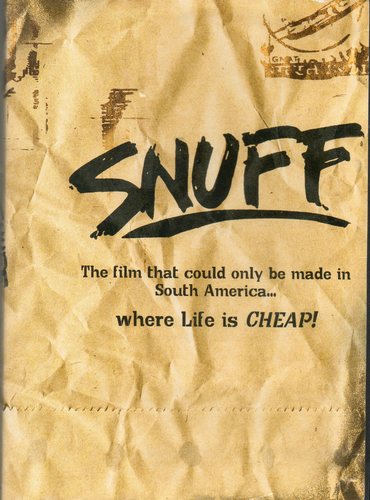 A stilted and amateurish exploitation quickie purported to be an actual snuff film. It’s not!
A stilted and amateurish exploitation quickie purported to be an actual snuff film. It’s not!
The real facts of SNUFF are well known, yet many people still persist in believing it an actual snuff film. In truth it was a trashy no budget Charles Manson cash-in called SLAUGHTER, filmed in Argentina by the notorious exploitation filmmaking team of Michael and Roberta Findley (then known for sleazers like TAKE ME NAKED, THE TOUCH OF HER FLESH and A THOUSAND PLEASURES). The film was completed in 1971 and given (very) scattered theatrical distribution.
SLAUGHTER was then purchased by Allan Shackleton of Monarch Releasing Corporation. In a desperate bid to recoup his investment, Shackleton tacked on a poorly shot final scene alleging that the makers of the film actually killed one of its actresses, and re-released it (sans credits) in 1976 under the title SNUFF. The snuff film ruse included fake Shackleton-penned newspaper clippings about a fictional attorney’s crusade to keep the film from release, which inspired a nationwide uproar. In this way SNUFF became one of the signature films of the grindhouse era, and kicked off the myth of the snuff film, which continues to intrigue and upset people today.
A young woman has ripped off a violent girl gang, whose members chase the thief down and torture her by cutting up her feet. Around the same time a man disembarking from a plane in South America is knifed in an airport restroom by one of the chicks from the previous scene, who’s dressed as a man. It turns out that the gals are under the control of a seductive Charles Manson-like freak named Satan.
Satan’s victims come to include a man stabbed to death at an outdoor soirée, which attracts police attention. More killings occur during a convenience store holdup, in which the elderly clerk is shot, along with an old woman and a young girl who had the misfortune to stop off at the store. Eventually Satan’s followers force their way onto the grounds of a luxurious estate, where they slaughter everyone in sight.
From there the action unconvincingly shifts to show what’s apparently happening behind the scenes. We see the director seduce one of the lead actresses, who becomes upset that they’re being filmed in the act. He responds by stabbing her in the shoulder, cutting off several fingers and then an entire hand, and finally scooping out her innards, at which point the film cuts to black.
SNUFF is for the most part fairly typical of the type of films made by director Mike Findlay and cinematographer Roberta Findlay in the late sixties-early seventies: it’s trashy and amateurish in the extreme, filled with outrageously stilted acting and unconvincing gore effects, and has a severely choppy, difficult-to-follow narrative. There’s much noticeable padding (such as documentary footage of an outdoor siesta that drags on forever) and gratuitous psychedelic interludes, and at one point the photography shifts to black-and-white for no apparent reason. There’s also an unintentionally hilarious flashback by one of the female leads, in which a man’s hands are chopped off and hung up as a keepsake and a little girl’s voice is unconvincingly dubbed by Ms. Findlay. In short, the film is total crap!
The notorious end sequence, shot several years after initial filming was completed, isn’t much better. It was lensed in a Manhattan loft with an actress who looks nothing like the woman she’s supposed to be portraying, and shot with distracting handheld camerawork. Featured are a plethora of gore effects that go beyond anything in the rest of the film in explicitness and extremity, yet are so unconvincing it’s hard to believe anyone was fooled into thinking they might actually be real. Yet fooled many people were, and apparently still are.
Vital Statistics
SNUFF
Monarch Releasing Corporation
Director: Michael Findlay
Producers: Jack Bravman, Allan Shackleton
Screenplay: Michael Findlay
Cinematography: Roberta Findlay
Cast: Margarita Amuchastegui, Ana Carro, Liliana Fernandez Blanco, Michael Findlay, Roberta Findlay, Alfredo Iglesias, Enrique Larratelli, Mirtha Massa, Aldo Mayo, Clao Villanueva
